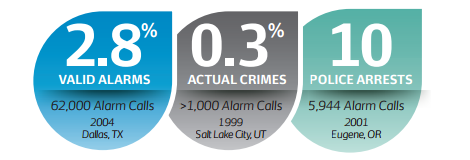![]()
The Benefits of Privatization
Even before the “Great Recession” of 2008-2009, law enforcement budgets were stretched thin. From Chicago to Texas and New York to California, many municipal police departments were obliged to institute hiring freezes or reduce the number of sworn officers. Despite these budget and labor constraints, however, law enforcement is being asked to assume even more responsibility for public safety and security. For example, in the wake of the September 11, 2001 terrorist attacks, some police are now tasked with securing vital infrastructure such as train stations, bridges, power plants, and more. As a consequence of providing more services with fewer resources:
 • Average response times by police have increased.
• Average response times by police have increased.
• Local governments have levied (or increased) fines on businesses and homeowners whenever police respond to false security alarms.
• A growing number of towns and cities have instituted Verified Alarm Response (VAR) policies. Accordingly, the police no longer respond to alarms unless video or eyewitness corroboration is first provided that an actual crime is in progress.
• Increasingly, businesses and homeowners are employing private security firms to patrol their neighborhoods. In Chicago, Milwaukee, New Orleans and New York, for example, the members of “business improvement districts” have pooled resources to hire private security officers. These officers patrol the streets, respond to alarms, interact with business owners, and serve as a supplemental deterrent to crime.
A Scalable Solution
The mobile guarding approach is also highly scalable. What works for a single location can work for multiple locations – even entire neighborhoods. Where officers once had to be physically present at control booths or entrances to gated communities, they can now monitor remotely using real-time reporting technology. This is already standard practice for many larger companies whose manufacturing plants in the Northeast can be monitored by highly-trained personnel in the mid-Atlantic, from which security officers can dispatch local responders almost instantly. Although a combination of remote and mobile guarding seems like an obvious solution for low activity posts, it’s also a viable option for locations experiencing high levels of activity. Working with homeowners’ associations, security personnel can patrol entire neighborhoods during designated times. In addition to deterrence, they can help to promote neighborhood rules and guidelines, help keep pools, parks and playgrounds secure after hours, and enforce traffic regulations and more.
Mobile units are a great value for these associations, since officers are not paid to staff a gatehouse or patrol 24/7, but patrol only at random intervals. Customers pay for only the proactive services they actually receive rather than for general “coverage.” In business improvement districts, mobile security can serve as an extra set of eyes and ears for the police, helping deter minor nuisances (littering, loud music, loitering) that can erode merchants’ ability to do business.

New Avenues for Security
More than ever, both the public and private sectors are challenged by seemingly contradictory goals – to increase the security of people and property and maintain (or reduce) the associated expenses. These expenses, which include wages, benefits, taxes, fees and fines, are unlikely to abate and will probably increase over the long term. It’s reasonable to expect, therefore, that costs affecting the security industry will continue to rise even as many customers are under intense pressure to contain overhead and operate more cost-effectively. This is where remote monitoring and mobile guarding alarm response can make a difference. The mobile monitoring and alarm response model allows commercial and residential property owners to enhance security while decreasing dependence on labor-intensive practices. Instead of simply employing more officers to provide more services, the best security firms deploy new technologies, tools and strategies to make each officer more productive.
Other benefits of Mobile Guarding and Alarm Response include:
Equipment and materials monitoring: Many manufacturing plants contain machinery or materials that must be kept at specific temperatures. Mobile security officers can check in, as needed, to confirm that these temperature (and other) specifications are met, and can even be trained to make minor adjustments.
Real-time reports:Advances in technology mean that mobile officers can create reports on-site, alerting business owners to any security issues within minutes of detection. Instead of arriving at the location to find a problem, customers arrive to a complete review of the night’s activity.
Shift coverage: Mobile officers can provide a friendly face and peace of mind for employees working solo shifts, especially during overnight hours. They can be posted at a front desk or lobby reception to cover employee breaks and provide parking lot escorts.
Power outages: In the event of a local or regional power outage, mobile officers will be alerted, and back-up officers dispatched to provide coverage at customers’ facilities.
IN SUM, private security is pioneering innovative new ways to do more with less.